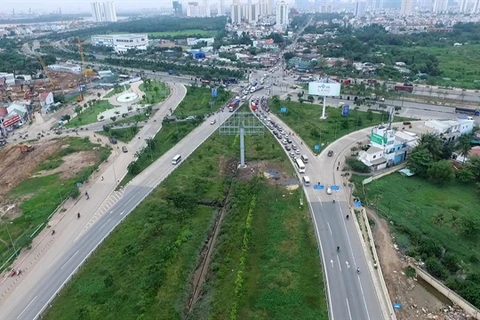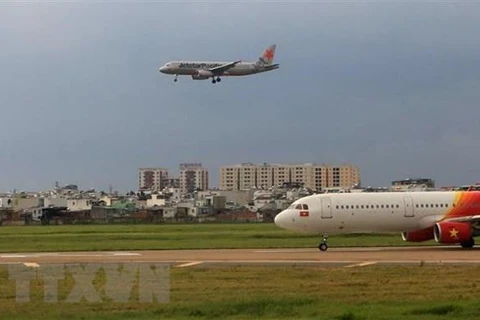Hanoi (VNS/VNA) - The State Bank of Vietnam (SBV) has said it would continue to direct credit institutions to strictly control credit in potentially-risky areas such as real estate and securities, especially Build-Operate-Transfer (BOT) and Build-Transfer (BT) transport projects.
This was part of the central bank's report sent to the eighth session of the 14th National Assembly recently, which will be discussed by delegates.
In the report, the SBV said many BOT and BT projects had been completed but were generating less revenue than planned, causing non-performing loans (NPLs) of about 53 trillion VND (2.27 billion USD).
The SBV has repeatedly warned commercial banks about lending to BOT and BT transport projects due to the potential risks in this area. SBV data showed that in the first nine months of this year, credit growth reached 9.4 percent compared with the same period last year, but loans for BOT and BT projects only increased by 1.85 percent.
Economist Vo Tri Thanh told Nguoi Lao dong (The Labourer) newspaper that the banking system’s credit resources for developing BOT and BT transport projects was not only important in Vietnam but also in many other countries.
“The risks of providing loans for these projects have been spoken about for years due to the large amount of capital involved and the length of the loans. If investors are unable to balance capital it can easily lead to bad debts,” Thanh said.
He said banks often mobilised short-term capital for medium and long-term loans. If the loan was too large, it could lead to risks, including liquidity shortages. That's why the SBV had asked commercial banks to reduce medium and long-term loans to reduce risks.
In order to remove difficulties and facilitate the effective implementation of lending activities for BOT transport projects to serve economic development, the SBV has suggested Prime Minister Nguyen Xuan Phuc to continue directing ministries and branches to closely cooperate and actively support the banking industry.
The bank said that mechanisms and policies needed to be perfected to mobilise long-term capital resources, which were in line with the long-term capital needs of BOT and BT projects. It was essential to focus on handling problems related to toll collections and implementing cashless collection services.
“The SBV’s recommendations to the Government do not only aim to find solutions for credit BOT and BT transport projects, but also reduce NPLs and clean up the banking system,” Thanh said.
"Some banks are already working to reduce the ratio of NPLs, so debt restructuring for some BOT and BT projects needs to be completed quickly," he added.
At a press conference to review the banking sector’s operations in the third quarter held in Hanoi recently, SBV Deputy Governor Dao Minh Tu said the banking system would still support BOT projects according to their financial conditions and capabilities, ensuring safety and efficiency for credit institutions.
However, Tu said ministries and branches must also clarify policies related to BOT projects to prevent risks such as low revenue from toll collections, which directly affected investors who had taken out loans from commercial banks.
“In the long term, it is necessary to have a mechanism to develop capital resources for transport and avoid reliance on bank capital,” Tu said./.
This was part of the central bank's report sent to the eighth session of the 14th National Assembly recently, which will be discussed by delegates.
In the report, the SBV said many BOT and BT projects had been completed but were generating less revenue than planned, causing non-performing loans (NPLs) of about 53 trillion VND (2.27 billion USD).
The SBV has repeatedly warned commercial banks about lending to BOT and BT transport projects due to the potential risks in this area. SBV data showed that in the first nine months of this year, credit growth reached 9.4 percent compared with the same period last year, but loans for BOT and BT projects only increased by 1.85 percent.
Economist Vo Tri Thanh told Nguoi Lao dong (The Labourer) newspaper that the banking system’s credit resources for developing BOT and BT transport projects was not only important in Vietnam but also in many other countries.
“The risks of providing loans for these projects have been spoken about for years due to the large amount of capital involved and the length of the loans. If investors are unable to balance capital it can easily lead to bad debts,” Thanh said.
He said banks often mobilised short-term capital for medium and long-term loans. If the loan was too large, it could lead to risks, including liquidity shortages. That's why the SBV had asked commercial banks to reduce medium and long-term loans to reduce risks.
In order to remove difficulties and facilitate the effective implementation of lending activities for BOT transport projects to serve economic development, the SBV has suggested Prime Minister Nguyen Xuan Phuc to continue directing ministries and branches to closely cooperate and actively support the banking industry.
The bank said that mechanisms and policies needed to be perfected to mobilise long-term capital resources, which were in line with the long-term capital needs of BOT and BT projects. It was essential to focus on handling problems related to toll collections and implementing cashless collection services.
“The SBV’s recommendations to the Government do not only aim to find solutions for credit BOT and BT transport projects, but also reduce NPLs and clean up the banking system,” Thanh said.
"Some banks are already working to reduce the ratio of NPLs, so debt restructuring for some BOT and BT projects needs to be completed quickly," he added.
At a press conference to review the banking sector’s operations in the third quarter held in Hanoi recently, SBV Deputy Governor Dao Minh Tu said the banking system would still support BOT projects according to their financial conditions and capabilities, ensuring safety and efficiency for credit institutions.
However, Tu said ministries and branches must also clarify policies related to BOT projects to prevent risks such as low revenue from toll collections, which directly affected investors who had taken out loans from commercial banks.
“In the long term, it is necessary to have a mechanism to develop capital resources for transport and avoid reliance on bank capital,” Tu said./.
VNA
























